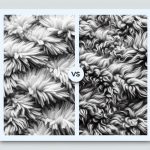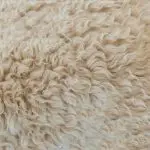When it comes to choosing between sherpa and wool for your outdoor gear, the age-old adage 'different strokes for different folks' holds true. Both materials have their own unique strengths and it ultimately depends on your specific needs and preferences.
In this comparison, you'll explore the insulation properties, durability, comfort, breathability, environmental impact, maintenance, and style of both sherpa and wool. By understanding the distinct qualities of each, you can make an informed decision that aligns with your mastery of outdoor apparel.
So, let's dive in and weigh the advantages of sherpa and wool to determine which one is better suited for your outdoor pursuits.
Key Takeaways
- Sherpa is lightweight insulation, while wool provides warmth in both dry and damp conditions.
- Wool is naturally resilient and durable, while Sherpa may not be as long-lasting due to synthetic fibers.
- Sherpa provides a plush and cozy feel, while wool offers comfort with natural elasticity.
- Wool is renowned for its breathability and moisture-wicking abilities, making it superior for base layers and demanding outdoor environments.
Insulation Properties
When comparing Sherpa and Wool for insulation properties, you'll find that Sherpa is known for its lightweight yet effective insulation, while Wool excels at providing warmth in both dry and damp conditions.
Sherpa fabric offers impressive thermal efficiency due to its air-trapping ability, creating a warm layer between the fabric and the body. This makes it an excellent choice for lightweight, all-day insulation.
On the other hand, Wool's insulation performance is exceptional in various conditions, making it a versatile option. Its natural ability to wick moisture away from the body while still providing warmth makes it suitable for both dry and damp environments.
When comparing the two materials, understanding their warmth assessment is crucial. Sherpa's insulation is effective for moderate cold, while Wool is more suitable for a wider range of temperatures, including cold and damp conditions.
Both materials have their strengths, with Sherpa excelling in lightweight insulation, and Wool offering versatility in varying weather conditions. Understanding the specific requirements will help in making an informed material comparison decision.
Durability and Longevity
For durability and longevity, consider the wear and tear each material withstands over time. When comparing Sherpa and wool, it's essential to evaluate their durability and longevity factors.
Here's a breakdown to help you understand the differences between the two:
- Durability Comparison:
- Wool is known for its exceptional durability, as its fibers are naturally resilient and can withstand extensive wear without losing their shape or structure.
- Sherpa, while durable, may not be as long-lasting as wool due to the nature of its synthetic fibers, which can be prone to pilling and matting over time.
- Longevity Factors:
- Wool has a proven track record of standing the test of time, making it a reliable choice for long-term use.
- Sherpa, although durable, may show signs of wear more quickly due to its synthetic composition.
In considering the durability comparison and longevity factors, wool emerges as the superior choice when prioritizing long-lasting, resilient material.
Comfort and Softness
Evaluate the comfort and softness of Sherpa and wool to determine which material best suits your needs.
When comparing the two, Sherpa is known for its incredible softness, providing a plush and cozy feel against the skin. The texture of Sherpa is often described as luxurious and velvety, offering warmth and comfort.
On the other hand, wool also offers exceptional comfort, with a natural elasticity that provides a gentle stretch and flexibility. The texture and feel of wool can vary depending on the type of wool used, but it's generally soft and smooth to the touch, making it comfortable for everyday wear.
Both materials excel in providing comfort, but the choice between Sherpa and wool ultimately comes down to personal preference and intended use. If you prioritize a velvety, plush feel, Sherpa may be the preferred option. Conversely, if you value a soft, smooth texture with natural elasticity, wool could be the ideal choice for your comfort needs.
In the end, the material comparison highlights the unique comfort attributes of both Sherpa and wool, offering distinct options for different preferences.
Breathability and Moisture-Wicking
To determine the breathability and moisture-wicking properties of Sherpa and wool, assess their performance in regulating body temperature and managing sweat. When it comes to outdoor activities and performance wear, breathability and moisture-wicking are crucial for comfort and performance. In the context of layering and winter clothing, these properties become even more important for maintaining warmth and staying dry.
Here are four key points to consider:
- Sherpa:
- This material is known for its excellent insulation properties, making it ideal for winter clothing.
- However, its breathability and moisture-wicking capabilities may not be as efficient as those of wool.
- Wool:
- Wool is renowned for its natural breathability and moisture-wicking abilities.
- It can effectively regulate body temperature and manage sweat, making it a great choice for outdoor activities and performance wear.
- Layering:
- Both Sherpa and wool can be used as part of a layering system for outdoor activities.
- However, wool's superior breathability and moisture-wicking properties make it a standout choice for base layers.
- Overall Performance:
- When it comes to breathability and moisture-wicking, wool outshines Sherpa, especially in demanding outdoor environments and performance wear.
Environmental Impact and Sustainability
When considering the environmental impact and sustainability of Sherpa and wool, prioritize the overall lifecycle and ecological footprint of each material.
Wool is a natural, renewable resource, with a relatively low environmental impact. Sheep, the source of wool, help maintain grasslands and pastures, contributing to biodiversity and healthy ecosystems. Additionally, wool is biodegradable, reducing its impact on the environment at the end of its lifecycle. Ethical sourcing is essential in ensuring sustainability, as it ensures that animal welfare and environmental conservation are prioritized throughout the production process.
On the other hand, Sherpa, often made from synthetic materials, can have a higher environmental impact due to the carbon footprint associated with its production. However, with the growing emphasis on sustainability, many companies are now producing Sherpa using recycled materials, which can significantly reduce its environmental impact.
When choosing between Sherpa and wool, it's important to consider the sourcing and production practices of each material to make an informed decision that aligns with your values and environmental impact priorities.
Maintenance and Care Requirements
When it comes to maintaining and caring for your Sherpa or wool items, there are important factors to consider. Understanding the durability of each material and the best cleaning and storage tips will help you prolong the life of your favorite pieces.
Let's compare the maintenance and care requirements of Sherpa and wool to help you make informed decisions about your wardrobe.
Sherpa Vs Wool Durability
You should consider the durability and maintenance requirements of both sherpa and wool before making a decision. When it comes to durability and care, there are some key differences between sherpa and wool to keep in mind:
- Abrasion Resistance: Sherpa fabric tends to have lower abrasion resistance compared to wool, making it more prone to pilling and wear over time.
- Maintenance: Wool requires more careful maintenance, often needing to be hand washed or dry cleaned to avoid shrinking or felting. On the other hand, sherpa can typically be machine washed and dried with ease.
- Longevity: Wool has a longer lifespan compared to sherpa, as it can withstand more wear and tear without losing its quality.
- Care Requirements: Sherpa is generally easier to care for and can withstand more frequent washing without losing its appearance or texture.
Considering these factors will help you make an informed decision based on your lifestyle and preferences.
Cleaning and Storage Tips
For easy maintenance and care of your sherpa or wool items, follow these recommended cleaning and storage tips.
When it comes to cleaning, gently spot clean any stains on sherpa with a mild detergent and warm water. Avoid using bleach or harsh chemicals as they can damage the fabric.
For wool, hand wash in cold water with a gentle detergent, then lay flat to dry to avoid stretching.
Both sherpa and wool should be stored in a cool, dry place to prevent moisture and mildew. Avoid hanging these items, as it can cause them to lose their shape.
Instead, fold and store them in a breathable fabric bag or a plastic storage bin with some cedar balls to ward off moths.
Following these cleaning tips and storage solutions will help prolong the life of your sherpa and wool items.
Style and Versatility
While wool is known for its classic and timeless style, sherpa offers a more casual and rugged versatility. When considering style and versatility, both fabrics have their unique attributes to offer. Here's a breakdown to help you understand the differences:
- Style Options:
- Wool is often associated with a more formal and polished look, making it ideal for professional settings or dressier occasions.
- On the other hand, sherpa exudes a more laid-back and relaxed vibe, perfect for casual outings and outdoor activities.
- Layering Possibilities:
- Wool is excellent for layering, providing warmth without adding bulk. It can be easily incorporated into various outfits, making it a versatile choice for different weather conditions.
- Sherpa, with its cozy and insulating properties, is also great for layering and can be styled with a wide range of casual ensembles.
- Occasion Suitability:
- Wool's sophistication makes it suitable for a wide range of settings, from business meetings to formal events.
- Meanwhile, sherpa's more casual nature makes it a go-to option for everyday wear, outdoor adventures, or relaxed social gatherings.
- Adaptability:
- Wool can easily transition from day to night, offering a seamless shift from professional attire to evening elegance.
- Sherpa, with its rugged appeal, seamlessly adapts to outdoor activities and informal gatherings.
Understanding the distinct style and versatility of both wool and sherpa allows you to make informed choices based on your preferences and lifestyle.
Frequently Asked Questions
Can Sherpa Be Used as a Sustainable Alternative to Wool?
Yes, sherpa can be a sustainable alternative to wool. Its environmental impact is lower, and it offers versatility in fashion. The dyeing process for sherpa can also be more eco-friendly, making it a viable choice.
How Do Sherpa and Wool Compare in Terms of Their Ability to Repel Moisture and Maintain Breathability?
Sherpa excels in moisture resistance and breathability, making it a top performer in outdoor gear. While wool also has good moisture-wicking properties, sherpa's sustainability and superior performance set it apart as an excellent choice for outdoor activities.
Are There Any Specific Care Instructions for Sherpa That Differ From Those for Wool?
For caring for sherpa, follow specific instructions to maintain fabric durability and moisture repellent properties. Dyeing techniques can affect care, so always check the label. Wool care might differ, but proper care ensures longevity for both fabrics.
Can Sherpa Be Dyed and Styled in the Same Way as Wool?
Yes, sherpa can be dyed and styled similarly to wool. Dyeing techniques for sherpa involve using fabric dye, while styling options include cutting, sewing, and embellishing. Both materials offer versatility for customization.
How Do Sherpa and Wool Differ in Terms of Their Versatility for Different Types of Clothing and Accessories?
When it comes to versatility for clothing and accessories, sherpa offers durability, while wool provides warmth. Sherpa is excellent for outdoor gear and linings, while wool shines in cozy sweaters and winter accessories.
- Is Chiffon Fabric Itchy? - April 23, 2024
- Are There Different Types of Chiffon Fabric? - April 23, 2024
- Can You Paint Chiffon Fabric? - April 23, 2024








